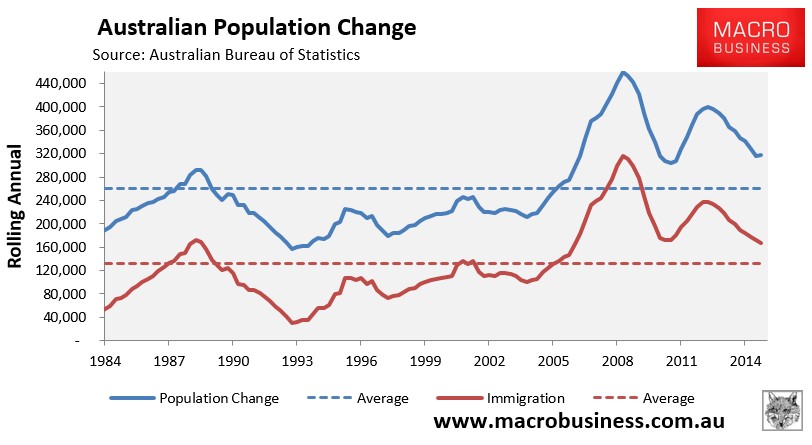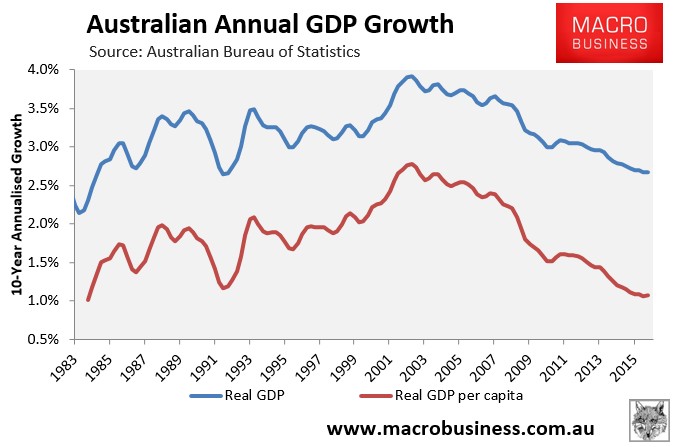Infrastructure Australia (IA) has once again warned that Australia’s economy and standard of living are under threat as strong population growth meets worsening infrastructure bottlenecks. From The International Business Times:
The main threat to Australia’s economic future is population growth outpacing infrastructure development, says Infrastructure Australia chairman Mark Birrell…
“Considered and well thought through infrastructure investment is going to be one of the most effective ways for us to achieve and deliver the qualities we want out of our economic growth,” he added.
Not acting would prove particularly costly given the increased infrastructure demands associated with population growth.
By 2031 the Australian population is expected to increase to over 30 million people from its current figure of 23.5 million, while congestion will come to cost $53.3 billion nationally and demand for public transport will double.
It is true that Australia faces crippling infrastructure bottlenecks and congestion – this is what happens when population growth is upped to Third World-levels, mostly via immigration (see next chart).

Meanwhile, real GDP per capita has fallen to levels not seen since the early-1980s recession:

As noted by Bob Carr last month:
Mr Carr said Australia had the highest rate of population growth of any developed country and that the growth was undermining policies by governments to make housing more affordable and to improve infrastructure. “It’s always never enough”…
The Australia Institute’s Richard Denniss was even more blunt in his assessment last year:
“Since the Sydney Olympics, Australia’s population has grown by the population of Sydney. Australia is one of the fastest growing countries in the developed world and our infrastructure isn’t keeping up. It isn’t keeping up now and hasn’t kept up for the last 10 years, and it’s not budgeted to keep up in the next 10″…
“If you were going to invite a hundred people to your house for a party, you would probably put the food and the chairs out before they arrive. But, what we have done for nearly 15 years now is we’ve significantly increased the rate of population growth and we are saying “we’ll build rail in the future… we’ll build the hospitals in the future”… What they [politicians] don’t say is that given that our population’s gonna grow by around 400,000 people this year, we are not building nearly enough hospitals and schools and roads to keep up with that…. [P]er person, the amount of infrastructure is declining. Per person, the amount of spending on health is declining”…
“If you want to double your population… you have to at least double your infrastructure to maintain people’s standard of living… We’re talking schools, we’re talking hospitals, we’re talking trains, we’re talking roads, we’re talking police”…
“Population growth costs a lot… If you double the number of citizens then you double the number of teachers and double the number of nurses. It’s pretty simple math. But of course, you don’t have to double them if you gradually plan to lower the number of services. If you are happy for us to gradually lower the number of services in our health system, our aged system, if you are happy for congestion to gradually get worse, if you are happy for the amount of green space per person to decline, then you can do what we do”.
So, one obvious solution to mitigate Australia’s infrastructure woes is to dramatically slow the rate of immigration.
The fact of the matter is that population growth costs a lot – either through massive infrastructure investment or, in the absence of such investment, via massive congestion, more expensive housing and overall lower amenity.
But like the frog that boils to death slowly, our politicians hope that we won’t notice, which is why they persist with third world level immigration in order to juice the economy. Their big business donors, too, love endless high immigration because they get to enjoy an ever growing customer base and are able to increase sales without becoming more efficient.
Meanwhile, the costs of this strategy fall on us and individual living standards continue to slide.

